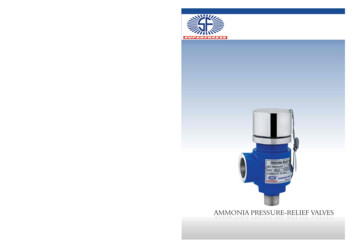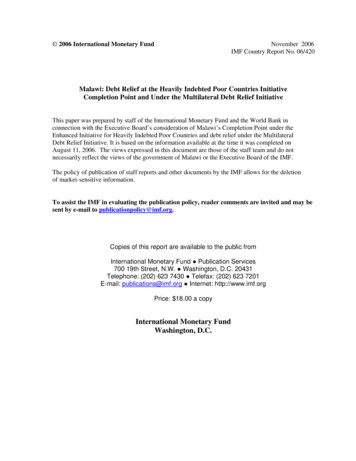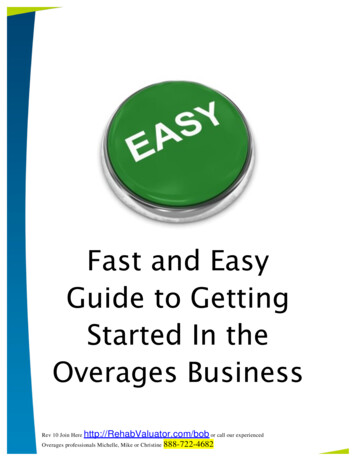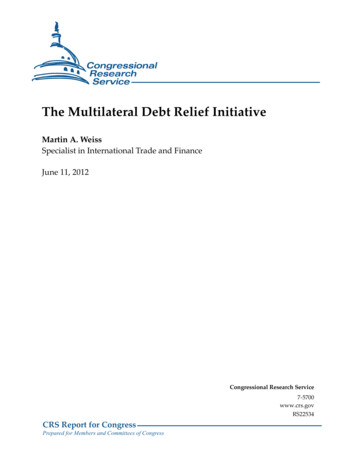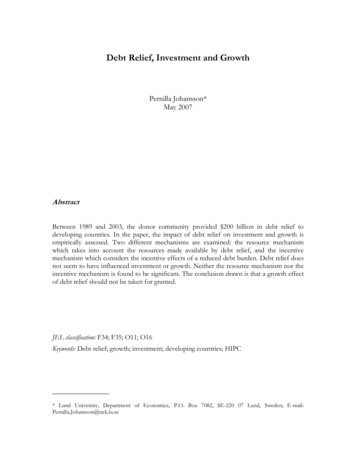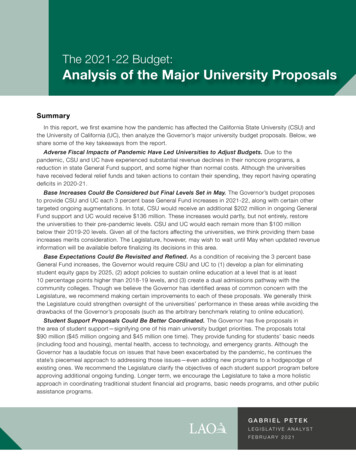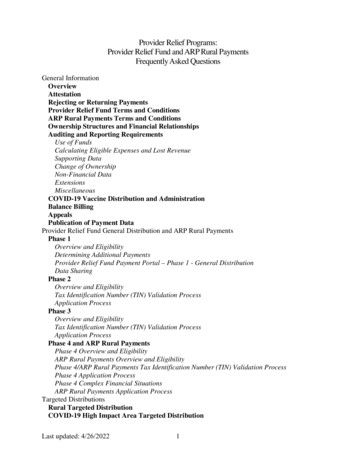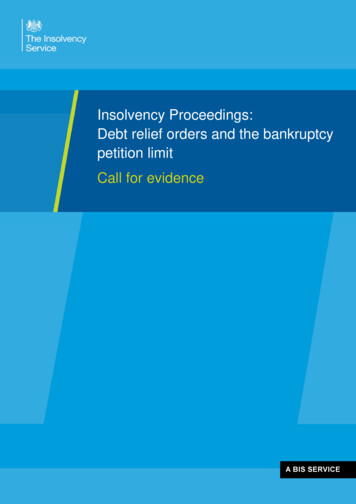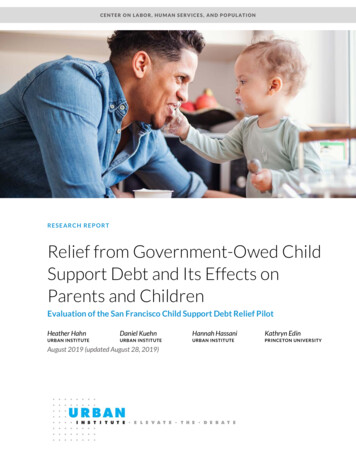
Transcription
CENTER ON LABOR, HUMAN SERVICES, AND POPULATIONRE S E AR C H RE P O R TRelief from Government-Owed ChildSupport Debt and Its Effects onParents and ChildrenEvaluation of the San Francisco Child Support Debt Relief PilotHeather HahnDaniel KuehnHannah HassaniKathryn EdinURBAN INSTITUTEURBAN INSTITUTEURBAN INSTITUTEPRINCETON UNIVERSITYAugust 2019 (updated August 28, 2019)
AB O U T T HE U R BA N I NS T I T U TEThe nonprofit Urban Institute is a leading research organization dedicated to developing evidence-based insightsthat improve people’s lives and strengthen communities. For 50 years, Urban has been the trusted source forrigorous analysis of complex social and economic issues; strategic advice to policymakers, philanthropists, andpractitioners; and new, promising ideas that expand opportunities for all. Our work inspires effective decisions thatadvance fairness and enhance the well-being of people and places.Copyright August 2019. Urban Institute. Permission is granted for reproduction of this file, with attribution to theUrban Institute. Cover image by Shutterstock/Halfpoint.
ContentsAcknowledgmentsvExecutive SummaryviErrataxiiiHow Relief from Government-Owed Child Support Debt StrengthensParents and Children1Pilot Participant Demographics2National Context for the Pilot4Pilot Results5Background: How Does the Public Assistance Payback System Work?Additional PenaltiesHow Did Parents Accrue Public Assistance Payback Debt?Child Support Orders Are Often UnaffordableInitial Orders Are Too High77999Volatile Employment and Income10Providing Informal Support11Modifying Child Support Orders Can Be Challenging12Debt Increases Quickly12Parents Choose between Paying Court-Ordered Child Supportand Directly Supporting ChildrenWhat Difference Did the Debt Relief Make in Parents’ Payments?1315Lower Child Support Debt Balances15More Consistent Child Support Payment16Feeling of Relief and Reduced Stress19Before the Debt Relief, Fathers Felt Haunted by the Debt19After the Debt Relief, Most of the Fathers in the Focus Groups Describeda Dramatic Reduction in Stress19Improved Credit Scores20Reduced Barriers to Employment22Improved Housing Status23Increased Feelings of Control Over Finances24Improved Relationships with Children24Debt Had Affected Fathers’ Moods and Therefore Their Relationships with Their Children25Debt Relief Changed the Nature of Their Relationships with Their Children25
Improved Relationships with Coparents26Some Focus Group Fathers Discussed How the Stress from the Debt AffectedTheir Coparenting Relationships27Improved Relationships with the Child Support System28Perspectives on Child Support before the Debt Relief28The Debt Relief Pilot Seemed Too Good to Be True30Perspectives on Child Support after the Debt Relief31Comparison with Traditional COAP Participants32Implications for Child Support System Revenues33Implications for the Public Assistance Payback Policy and the Child Support System36Concluding Observations38Appendix. Methods39Administrative Data Analysis Methods and Results39Focus Groups41Survey Methods42Notes43References44About the Authors46Statement of Independence48IVCONTENTS
AcknowledgmentsThis report was funded by Tipping Point Community. We are grateful to Tipping Point and to all ourfunders, who make it possible for Urban to advance its mission.The views expressed are those of the authors and should not be attributed to the Urban Institute,its trustees, or its funders. Funders do not determine research findings or the insights andrecommendations of Urban experts. Further information on the Urban Institute’s funding principles isavailable at urban.org/fundingprinciples.The authors would like to thank Jamie Austin and Jake Leos-Urbel, Tipping Point Community; ChristaBrown and Anne Stuhldreher, Financial Justice Project, San Francisco Office of the Treasurer; KarenMaria Roye, Director, San Francisco Department of Child Support Services; and Freda Randolph, SanFrancisco Department of Child Support Services, for generously sharing their knowledge, time, andexpertise. We also are grateful to the parents who bravely shared their stories with us to help othersunderstand the realities of their lives. We could not have done this work without them. In addition, wethank our colleague Elizabeth Peters for reviewing and improving the draft report. Any errors oromissions are our own.ACKNOWLEDGMENTSV
Executive SummaryMost of the money many low-income Californians pay for child support does not reachtheir children; instead, it reimburses the government for public assistance their childrenhave received. In California, 40 percent of child support payments are for debt owed tothe government. What would happen if 100 percent of parents’ payments went to theirchildren, rather than the government? What benefits would accrue to children andparents? The San Francisco child support debt relief pilot tested this possibility, and theresults are clear. When parents’ public assistance debt is paid off, so 100 percent of theirchild support payments goes to their children, parents make more consistent and timelypayments, children receive more financial support, parents’ employment barriers arereduced, and parents’ housing status and credit scores often improve. Parents’relationships with each other and their children also improve.The majority of parents with government-owed child support debt earn under 15,000 a year. Ifparents miss a child support payment or don’t pay the full amount, they begin to accrue publicassistance payback debt, which grows with 10 percent interest. When parents cannot pay, their driver’sand professional licenses can be suspended, up to 65 percent of their paycheck can be garnished, andthey can be jailed.Recognizing the multiple challenges the public assistance payback policy creates, the state ofCalifornia, the local child support agency in San Francisco, the city’s Financial Justice Project, andphilanthropic partners collaborated to help low-income parents paying child support in San Franciscoeliminate their public assistance payback debt. Since before the pilot, parents have had the opportunityto obtain debt relief through the state’s Compromise of Arrears Program (COAP), which allows eligibleparents to make a partial payment toward their public assistance payback debt and have the rest oftheir government-owed debt eliminated. COAP was created to ensure that children benefited fullyfrom their noncustodial parents’ support payments. However, many parents find it difficult to make thepartial payment required by COAP and challenging to navigate the lengthy application process. Toimprove the system, the state has looked to counties to pilot different, innovative approaches.Using philanthropic funding from the Walter & Elise Haas Fund, the pilot partners paid down theportion of participants’ public assistance payback debt needed to eliminate their remaining debtthrough COAP. So participants received full debt relief through the pilot project. Moving forward, 100percent of any payments made by the pilot participants will go to their families, as long as they remainVIEXECUTIVE SUMMARY
current on their payments. This pilot provided an opportunity to test the effect of debt relief onparticipating parents.With support from Tipping Point Community, an organization focused on fighting poverty in theBay Area, the authors evaluated the debt relief’s effects on the parents’ compliance with current childsupport orders, employment, financial stability, relationships with their children, and other aspects ofwell-being. The evaluation uses administrative data from the local child support agency to estimate thedebt relief pilot’s effect on payment behavior. Since administrative data were not available onemployment, financial stability, and parents’ relationships with their children, the authors surveyed andconducted focus groups with pilot participants to study these outcomes. Quotes from surveyrespondents and focus group participants are cited throughout the report using pseudonyms theychose for themselves.How Did Parents Accrue Public Assistance PaybackDebt?When a child receives public assistance in California, the human services agency automatically sends achild support referral to the local child support agency. The child support agency then reviews thereferral and determines whether to open a child support case or reject the referral. Parentsparticipating in certain public assistance programs may be required to cooperate with the child supportprogram and assign their rights to child support payments to the state in compensation for the publicassistance they receive. Child support orders are often unaffordable, according to pilot parents. California hasprovisions to adjust orders for low-income parents, but parents in the pilot reported that theirorders were still daunting and unaffordable. Parents may also find that orders becomeunaffordable as their incomes change—as they often do for low-wage workers—or when theybecome unemployed or are out of the workforce because of disability, college attendance, orincarceration. Some parents have found that they owe child support debt to the governmentfor public assistance their families received while they were providing informal support to theirchildren. The state of California, through COAP, allows eligible noncustodial parents to paypart of their public assistance payback debt and eliminate their remaining government-oweddebt. However, for some parents, even the partial payment is more than they can afford.EXECUTIVE SUMMARYVII
California’s high interest rate for child support debt quickly increases the amount due. If anoncustodial parent falls behind in child support payments, California charges 10 percentannual interest on the overdue amount, causing the amount owed to increase quickly. Penalties are stiff. In addition, if parents’ payments are more than 30 days late, their driver’slicenses can be suspended, their professional licenses may be revoked, and the state maygarnish up to 50 percent of their take-home pay and seize other financial assets. In some cases,up to 65 percent of the noncustodial parent’s take-home pay can be garnished if the local childsupport agency pursues it through the court.It’s on top of you trying to pay your regular child support, and then on top of that, you’retrying to pay your back child support [to the government], and then on top of your back childsupport, you’re trying to pay that interest. It’s like where do I get a relief at?—Joe Parents choose between repaying child support to the government and supporting theirchildren. High payments (including both current orders and public assistance payback debt)lead some parents to feel they must choose between paying formal child support (whichamounts to repaying the government for public assistance benefits paid to their children) andsupporting their children directly. Many fathers who participated in focus groups for thisevaluation acutely felt the paradox that repaying child support to the government diminishedtheir financially capacity to provide for their children.I have to choose between paying child support and supporting my child.— krillaVIIIEXECUTIVE SUMMARY
What Difference Did the Debt Relief Make?Eliminating the government-owed child support debt contributed to numerous positive changes inparents’ lives that may also have positive spillover effects for their children. Debt relief resulted in more consistent child support payments. Parents who participated inthe debt relief pilot consistently made their monthly child support payments on time. Theirpayment consistency was 18 to 28 percent higher, depending on the month, than for similarparents who had not received complete debt relief. 1 This runs counter to a primary argumentfor charging interest on government-owed child support debt: the assumption that itincentivizes parents to pay on time. The pilot showed that debt relief—not accumulating debt—resulted in more consistent timely payments. More consistent child support payments also helpguarantee that collections levels do not unduly suffer from the debt relief effort. Downward spirals were turned around, empowering parents to support their children. Owingpublic assistance payback debt was a source of enormous stress in parents’ lives, and theelimination of the debt and its associated stress contributed to reduced barriers to employmentand improved credit scores, housing status, and feelings of control over finances, according toboth focus group participants and survey respondents. Participants reported improvedrelationships with their children, their coparents, and the child support system.The relief program made me see at the end of the tunnel there will be a better life for me andfor my kids.—Anonymous survey respondentIn addition to lowering participants’ public assistance payback debt and improving their paymentconsistency, the debt relief pilot contributed to the following positive outcomes: Reduced stress. Haunted by the debt before the pilot, fathers in the focus groups describeddramatic stress reduction after the debt relief. Improved credit scores, housing status, and feelings of control over finances. Elimination ofgovernment-owed debt and increased consistency of child support payments resulted in highercredit scores, according to some parents, allowing them to qualify for housing, car loans, creditEXECUTIVE SUMMARYIX
cards, and employment. For some parents, improved housing and transportation meantincreased ability to share custody and visit their children.Reduced barriers to employment. Relieving the public assistance payback debt reduced barriers to employment, such as drivers’ and professional license suspensions.Improved relationships with children and coparents. Many parents reported that the government-owed debt created conflict between coparents. Relief of financial and emotionalburdens positively affected parents’ relationships and activities with their children andcoparents. Parents expressed that after the debt relief they could more effectively coparentand better afford to financially support their children.Improved relationships with the child support system. Before the debt relief, parents felt that the child support system was punitive, unfair, and biased against fathers, but after they beganto trust and cooperate with the Department of Child Support Services and believe their voiceswould be heard.They took a look at my credit report. I mean, it wasn’t the greatest but it’s a lot better than400. I was able to get into a spot. I was able to actually rent a car after that. And now I canwork for Lyft because I’m using their rental car program.—ArtieImplications for the Public Assistance Payback Policy andthe Child Support SystemThe debt relief pilot results and participants’ experiences suggest changes to the child support systemthat could promote parents’ support for their children.Allow 100 percent of parents’ child support payments to go to their family. When parents know that all their child support payments go to their children, they pay more and they paymore often. Parents will no longer have to choose between paying formal child support to thegovernment and directly supporting their children.XEXECUTIVE SUMMARY
Do not charge interest. For parents who are already struggling to pay their child supportobligations, additional interest payments make paying off their debt seem impossible. Forgive government-owed child support debt. The debt relief pilot demonstrated thatforgiving child support debt owed to the government can produce myriad positive outcomes forfamilies and for payment behavior. Ensure all parents feel heard and respected in court. Many fathers in the focus groups feltunheard and powerless in the court and perceived child support judges as biased againstparents who owe child support. Research shows that courts focused on respecting andempowering both parents can yield improved well-being for parents and children (Hahn, Edin,and Abrahams 2018; Marczak, Becher, et al. 2015; Marczak, Galos, et al. 2015). Recognize that parents want to support their children. In contrast to pervasive negativestereotypes, many fathers from the focus groups wanted to be and were actively and positivelyengaged in their children’s lives, providing both financial and emotional support. Make the child support system more welcoming. Though several fathers in the focus groupsfelt before the debt relief that the child support system did not care about them, with theirnewfound understanding that “They’re there to help sometimes,” fathers encouraged theirfriends to trust the child support system.Concluding ObservationsThe pervasive narrative of parents “shirking responsibility” may lead some to reject the idea of forgivinggovernment-owed child support debt, but this pilot adds evidence that these stereotypes are false andracist. 2 In fact, punitive policies contribute to the debt in the first place (Edin 2018).The evaluation of the San Francisco debt relief pilot illustrates how complete debt relieftransformed many parents’ experiences from one of despair and missed opportunities to one ofimproved well-being for parents and children. By collaborating in this innovative pilot, the state ofCalifornia, the local child support agency in San Francisco, the city’s Financial Justice Project, andphilanthropic partners demonstrated the benefits of recognizing parents’ desire to support theirchildren and empowering parents to give that support.EXECUTIVE SUMMARYXI
ErrataThis report was updated on August 28, 2019. On page vi, the share of child support payments inCalifornia that is owed to the government was changed from 70 percent to 40 percent to reflect themost recent data. On page 2, “In San Francisco” was changed to “According to the San FranciscoDepartment of Child Support Services” to clarify the source of the percentage in the first paragraph.ERRATAXIII
How Relief from Government-OwedChild Support Debt StrengthensParents and ChildrenFor many low-income parents paying child support, most of their payments do not reach their childrenbut rather reimburse the government for public assistance their children have received in the past. InCalifornia, if parents fall behind in these payments to the government, the state charges 10 percentannual interest on the overdue amount. Recognizing the multiple challenges this payback policy creates,the state of California, the local child support agency in San Francisco, the city’s Financial JusticeProject, and philanthropic partners collaborated to help low-income parents paying child supporteliminate their debt associated with reimbursing the government for public assistance. The state’s longstanding Compromise of Arrears Program (COAP) allows eligible parents to make a partial paymenttoward their public assistance payback debt and have the rest of their government-owed debteliminated. Leveraging philanthropic dollars from the Walter & Elise Haas Fund, parents in the pilotwere able to make the partial payment to eliminate all of their government-owed debt through theCOAP. This allowed all of their future payments to go directly to their family.Almost two decades ago, the state of California recognized the problem that debt owed togovernment posed for the California children and families receiving child support. In 2000, the statepassed a one-time amnesty program for individuals with government-owed child support debt thatexceeded 5,000. A few years later, the state contracted with the Urban Institute to study the problemfurther, which resulted in the 2003 report Examining Child Support Arears in California. The UrbanInstitute found that in California at that time, three-quarters of the public assistance payback debtresulted from original orders that didn’t take into account the parent’s income and ability to pay, anissue that has since improved (Sorensen et al. 2003). The Urban Institute estimated in 2003 that onlyabout a quarter of this debt was collectible. Most parents owing reimbursement debt to thegovernment have low incomes. The 2003 report also suggested that most child support debt inCalifornia is owed by parents making less than 10,000 a year, and most owe more than 20,000(Sorensen et al. 2003). Currently, the median annual income of parents paying child support inCalifornia is about 14,600 (Insight et al. 2019).Partially in response to these findings, the state passed compromise-of-arrears legislation thatrecognized the reality of the debt collection problem and the burden of government debt on families.
The legislation established the Compromise of Arrears Program in 2003, which allowed eligible parentsto make a partial payment of their debt and have the rest of their government-owed debt forgiven. TheCOAP guaranteed that some arrears were eventually paid while freeing families from the burden of theremaining debt. Even with the COAP in place, the few parents who participate often have a difficulttime coming up with the money, navigating the application, and making their partial payment. Accordingto the San Francisco Department of Child Support Services, more than 70 percent of child support casesare related to families receiving public assistance either currently or in the past, meaning that most oftheir payments go to the government, not their children. Most of these children are no longer receivingpublic assistance, so money from noncustodial parents could provide vital support. Recognizing thesebarriers, the Department of Child Support Services has encouraged counties to seek innovative ways tofurther improve the COAP. The San Francisco debt relief pilot is a key example of such an innovation.Pilot Participant DemographicsThe 30 fathers and 2 mothers receiving debt relief through the pilot were paying support for children ofall ages. About one in three (34 percent) were paying support for at least one child age 5 or younger, andalmost one in ten (9 percent) had a youngest dependent child who was no more than 1 year old. Onequarter of parents had youngest dependent children who were teenagers. Half the parents only had onedependent. Overall, the 32 parents in the pilot were responsible for 55 dependent children. Parents’support of and involvement with their children is associated with positive child outcomes—both shapinga young child’s trajectory and an adolescent’s psychological well-being.Building on the state’s existing COAP, the debt relief pilot tests the hypothesis that eliminating allpublic assistance payback debt owed to the government would yield strongly positive results for bothparents and children and increase access to COAP. The debt relief pilot was offered to all parents withcurrent child support obligations in San Francisco who met the following criteria: (1) resided in the nineBay Area counties; (2) owed between 500 and 50,000 in government-owed child support debt; (3)were making some effort to meet their debt obligations; (4) had a current child support obligation(payable to the family); and (5) the custodial parents formerly received, but were not currentlyreceiving, cash assistance through CalWORKs, California’s Temporary Assistance for Needy Families(TANF) program. Pilot participants were required to attend a four-hour financial coaching workshopand were expected to stay current on child support payments to their children for at least one year. Intotal 32 parents met these criteria and voluntarily agreed to participate in the pilot to have theirgovernment-owed child support debt eliminated. 32CHILD SUPPORT DEBT RELIEF STRENGTHENS PARENTS AND CHILDREN
BOX 1Debt Relief Financial Coaching WorkshopAs a condition of receiving debt relief, pilot participants were required to attend a four-hour financialcoaching workshop that explained the requirements of the pilot and covered basic financial capabilitytopics such as budgeting and savings. The workshops were intended to help participants understandtheir finances and plan for payments.Fathers in the focus groups spoke very positively of the workshop and how they acted on what theylearned, such as which bills to pay first and how to improve their credit scores. krilla said it provided “alot of information I could use and benefit from” and that he has applied that knowledge. “Just the way Isave money and spend money now,” he said. “It kind of opened my eyes on how to make it easier formyself.” Shawn noted how “down-to-earth” and relatable the instructor was and said, “A lot of goodthings that stuck with me since then. Like, the lady, she said, ‘If you say yes to something now, you’regonna be saying no to something else later. But if you say no now, you’ll be saying yes later.’” Hefollowed that advice, saved his money, and said, “I got a car now. Doing good.”Though not part of the formal curriculum, the fathers mentioned that they had also discussed topicsrelated to parenting and coparenting. Several fathers credited the workshop with giving them skills andstrategies for improving their coparenting relationships, including not undermining or undercuttingtheir children’s mother. For example, one father said that when his children ask his permission forsomething, he first asks, “What did your mother say?” and will not contradict her decision. Theworkshop also influenced their strategies with their children, such as giving gifts in recognition ofchildren’s accomplishments rather than giving children anything they wish. In other words, they learnedto win their children’s respect through good parenting rather than bribery. “I stopped spoiling my kidstoo much,” Shawn said. “It really helped,” he said, noting his children’s recent academic and athleticachievements.The official certificate fathers received for completing the workshop was remarkably meaningful tothem. “[I] got my certificate on the wall,” Shawn said. Sam said, “I don’t throw it away but keep it. Iappreciate it, honestly. Somebody did something good to me. I feel like I am in good situation.” Fathersalso felt the certificate legitimized the debt relief pilot and demonstrated that they had done somethingto earn it. “I actually got the little certificate, that was kind of official,” Artie said. “They did a littlecertificate with our name on it so I was like, ‘Alright, now I have something that kind of proves.thatthey might be going to their word right here.’”The debt relief pilot participants were racially and ethnically diverse. Eleven of the parents wereblack and twelve were Latinx, according to child support administrative records. Two parents wereFilipino, one was Samoan, and one was white. The race and ethnicity of the remaining three parents wasnot recorded in the Department of Child Support’s data system. The 32 parents who participated in theCHILD SUPPORT DEBT RELIEF STRENGTHENS PARENTS AND CHILDREN3
pilot were invited to share their experiences in the focus groups, and 10 participants, all of whom werefathers, agreed to join. The 10 fathers sharing their stories in the focus groups identified as AfricanAmerican, Latinx, white, and Native American; had children ranging in age from 16 months to 42 years;and were currently paying child support for children ages 3 to 18. Among the fathers were securityguards, a software engineer, an electrical technician, a building supply salesman, a chef, a bartender, andlimousines, Lyft, and taxi cab drivers.National Context for the PilotThe debt relief pilot was based on research showing that government-owed child support debt createsbarriers to successful employment, family relationships, and self-sufficiency, and that when parentssupport their children financially and spend time with them, children benefit in the short and long term(Insight et al. 2019). Research suggests that when a child receives money through child support thetransfer may have a greater effect than other sources of family income on their school performance andbehavior, indicating that it is meaningful to children that the support comes from a parent (Amato andGilbreth 1999; Argys et al. 1998; Graham, Beller, and Hernendez 1994; Knox 1996). Studies also showthat when child support payments go directly to their children, parents are more likely to pay support(Cancian, Meyer, and Caspar 2008; Lippold, Nichols, and Sorensen 2013). Recently, when Coloradoeliminated public assistance payback requirements and began giving families all of the support paid ontheir behalf, the total amount of child support payments increased by 63 percent in the first year ofimplementation (Insight et al. 2019).Nationally, there has been growing recognition of the concerns raised in California almost twodecades ago that using child support payments to reimburse the government for public assistance andimposing penalties on parents who are unable to afford their child support orders can becounterproductive (Hahn, Edin, and Abraham 2018; Insight et al. 2019). Changes to federal laws andrules over the past two decades have given states increased flexibility to reform their child supportprograms to better serve low-income families. For example, a 2006 law gave states the option to pass allchild support payments to families and eliminate some older debt. 4 A 2016 rule change requires statesto, among other things, more carefully consider parents’ ability to pay when establishing child supportorders and before incarcerating parents for failure to pay. 5As a result, the majority of states now offer parents a pathway to relieve public assistance paybackdebt. Some states have policies that allow county or state departments of child support services toforgive public assistance debt based on income, assets, and other criteria, and several states offer debt4CHILD SUPPORT DEBT RELIEF STRENGTHENS PARENTS AND CHILDREN
forgiveness for parents that are current on monthly payments. San Francisco’s pilot builds on thenational trend of states looking for ways to elim
Debt relief resulted in more consistent child support payments. Parents who participated in the debt relief pilot consistently made their monthly child support payments on time. Their payment consistency was 18 to 28 percent higher, depending on the month, than for similar parents who had not received complete debt relief. 1
